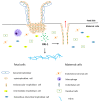Role of Plasminogen Activator Inhibitor Type 1 in Pathologies of Female Reproductive Diseases
- PMID: 28758928
- PMCID: PMC5578041
- DOI: 10.3390/ijms18081651
Role of Plasminogen Activator Inhibitor Type 1 in Pathologies of Female Reproductive Diseases
Abstract
Normal pregnancy is a state of hypercoagulability with diminishing fibrinolytic activity, which is mainly caused by an increase of plasminogen activator inhibitor type 1 (PAI-1). PAI-1 is the main inhibitor of plasminogen activators, including tissue-type plasminogen activator (tPA) and urokinase-type plasminogen activator (uPA). In human placentas, PAI-1 is expressed in extravillous interstitial trophoblasts and vascular trophoblasts. During implantation and placentation, PAI-1 is responsible for inhibiting extra cellular matrix (ECM) degradation, thereby causing an inhibition of trophoblasts invasion. In the present study, we have reviewed the literature of various reproductive diseases where PAI-1 plays a role. PAI-1 levels are increased in patients with recurrent pregnancy losses (RPL), preeclampsia, intrauterine growth restriction (IUGR), gestational diabetes mellitus (GDM) in the previous pregnancy, endometriosis and polycystic ovary syndrome (PCOS). In general, an increased expression of PAI-1 in the blood is associated with an increased risk for infertility and a worse pregnancy outcome. GDM and PCOS are related to the genetic role of the 4G/5G polymorphism of PAI-1. This review provides an overview of the current knowledge of the role of PAI-1 in reproductive diseases. PAI-1 represents a promising monitoring biomarker for reproductive diseases and may be a treatment target in the near future.
Keywords: endometriosis; gestational diabetes mellitus; intrauterine growth restriction; plasminogen activator inhibitor type 1; polycystic ovary syndrome; preeclampsia; recurrent pregnancy losses; trophoblast invasion.
Conflict of interest statement
The authors declare no conflict of interest.
Figures


Similar articles
-
The role of plasminogen activator inhibitor-1 in gynecological and obstetrical diseases: An update review.J Reprod Immunol. 2022 Mar;150:103490. doi: 10.1016/j.jri.2022.103490. Epub 2022 Jan 29. J Reprod Immunol. 2022. PMID: 35121287 Review.
-
Plasminogen activator inhibitor activity, 4G5G polymorphism of the plasminogen activator inhibitor 1 gene, and first-trimester miscarriage in women with polycystic ovary syndrome.Metabolism. 2006 Mar;55(3):345-52. doi: 10.1016/j.metabol.2005.09.008. Metabolism. 2006. PMID: 16483878
-
Expression of urokinase, plasminogen activator inhibitors and urokinase receptor in pregnant rhesus monkey uterus during early placentation.Placenta. 2000 Mar-Apr;21(2-3):184-93. doi: 10.1053/plac.1999.0446. Placenta. 2000. PMID: 10736241
-
Fibrinolysis: the key to new pathogenetic mechanisms.Curr Med Chem. 2008;15(9):923-9. doi: 10.2174/092986708783955455. Curr Med Chem. 2008. PMID: 18473800 Review.
-
[Reproductive problems in women with PCOS, the impact of PAI-1 carriers of 4G PAI-1 polymorphism and BMI].Akush Ginekol (Sofiia). 2014;53(6):15-21. Akush Ginekol (Sofiia). 2014. PMID: 25672133 Bulgarian.
Cited by
-
Circulating adipokine levels and preeclampsia: A bidirectional Mendelian randomization study.Front Genet. 2022 Aug 22;13:935757. doi: 10.3389/fgene.2022.935757. eCollection 2022. Front Genet. 2022. PMID: 36072663 Free PMC article.
-
Plasminogen activator inhibitor 1 and gestational diabetes: the causal relationship.Diabetol Metab Syndr. 2022 Sep 8;14(1):127. doi: 10.1186/s13098-022-00900-2. Diabetol Metab Syndr. 2022. PMID: 36076264 Free PMC article. Review.
-
Palmitic acid induces inflammation in placental trophoblasts and impairs their migration toward smooth muscle cells through plasminogen activator inhibitor-1.Mol Hum Reprod. 2020 Nov 1;26(11):850-865. doi: 10.1093/molehr/gaaa061. Mol Hum Reprod. 2020. PMID: 32898274 Free PMC article.
-
Molecular basis of senescence transmitting in the population of human endometrial stromal cells.Aging (Albany NY). 2019 Nov 5;11(21):9912-9931. doi: 10.18632/aging.102441. Epub 2019 Nov 5. Aging (Albany NY). 2019. PMID: 31689238 Free PMC article.
-
Anti α-enolase antibody is a novel autoimmune biomarker for unexplained recurrent miscarriages.EBioMedicine. 2019 Mar;41:610-622. doi: 10.1016/j.ebiom.2019.02.027. Epub 2019 Mar 1. EBioMedicine. 2019. PMID: 30827932 Free PMC article.
References
-
- Jorgensen M., Philips M., Thorsen S., Selmer J., Zeuthen J. Plasminogen activator inhibitor-1 is the primary inhibitor of tissue-type plasminogen activator in pregnancy plasma. Thromb. Haemost. 1987;58:872–878. - PubMed
Publication types
MeSH terms
Substances
LinkOut - more resources
Full Text Sources
Other Literature Sources
Medical
Miscellaneous

